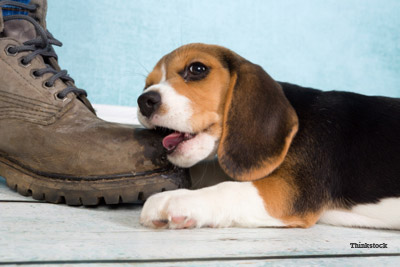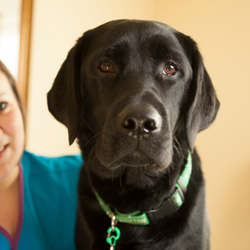
Some things were destined to go together: French fries and ketchup, wine and cheese, dogs and chewing. Yes, I went there. One of the most common questions I hear from frazzled pet parents donning mismatched socks and tattered footwear is, “Why does my dog chew everything?” Settle in, grab a glass of vino, and allow me to share tips on curbing chewing in dogs.
Dog chewing is natural
Dogs are curious critters. They explore the world around them by sight, sound, smell, and taste. Unfortunately for your favorite pair of Louboutin’s, many of these canine life lessons involve putting things in their mouth. I explain to pet parents that a dog uses its mouth a lot like humans use our hands. They’re not tasting your shoes, they’re feeling them. And, yeah, feeling with your mouth looks a lot like chewing.
There are plenty of other reason dogs crunch on our stuff. Puppies three to six months of age often chomp when teething. Dogs at play typically bite and carry objects. Really hungry dogs may gnaw when searching for something to eat. Chewing objects may also aid in keeping teeth and gums clean and healthy.
Dog chewing associated with a behavioral problem
Some dogs chew for attention or treats. For example, I once treated a Chihuahua that would bark and chew on a kitchen chair leg several times a day. Every time the dog did, the guardian shushed him and gave him a cookie. She was inadvertently rewarding and encouraging the chewing. Did I mention the pooch was a bit portly?
I’ve also seen many dogs that chewed due to anxiety. I’ll never forget an Irish setter that chomped madly on a teddy bear whenever he rode in a car. One time the guardian left in a hurry without the toy; it cost her over $500 to replace two seatbelts. Dogs that feel stressed, confined to crates/backyards or suffer from separation anxiety may turn to chewing in an attempt to ease their angst. These dogs are in a constant state of emotional conflict, heightened arousal, and stress. For them, the only way out seems to be destructive behaviors. Like many veterinarians, I’ve treated dogs that have chewed through sheetrock and doors. For the record, I’d prefer they destroyed your Louboutin’s. It’s safer – and cheaper.
Analyzing a dog chewing problem
The first step is to work with your veterinarian to determine what triggers the chewing. Young pups and early adults are probably investigating and playing. Chewing doorways may be separation or confinement anxiety-related. I ask clients to keep a one-week “chew diary” to detect patterns and accurately assess the extent of the problem. I also evaluate if the dog is receiving adequate interactive playtime, exercise, and environmental enrichment. Videotaping with remote baby monitors or cell phones is an excellent way to glimpse into the dog’s psyche and better understand the problem.
Treating dog chewing
Excessive or destructive chewing is normally based on some emotional requirement such as curiosity, boredom or anxiety. Treatment begins by ensuring the dog is exercising enough, has plenty of social interaction and playtime, and ample opportunity to explore. Next, try a variety of different chew toys with varying shapes, colors, sizes, textures, tastes and odors to find their favorites. Some dogs prefer indestructible toys while others require something they can ravage. You can also try coating the toy with peanut or coconut butter or stuffing with food or cheese spreads. I particularly like food puzzle chew toys that dispense kibble when bowled around. Rotate chew toys when you leave the house. At my house, I trade toys out every two to three days and pack the others in a drawer. No matter how long my mutts have had a toy, they get super-excited whenever we reach into that drawer and withdraw a “new” plaything.
If your dog continues to chew on household objects, furniture, or clothing, you need to see your veterinarian. If you return from work and find a cushion eviscerated, do not punish your dog. A dog’s sense of time can’t link the earlier destruction with your later screaming or spanking. Ask your veterinarian about using taste and odor aversion tools, household behavioral booby-traps, and training tactics. I’ve had success in complex cases with alarm mats, motion detector sprays, bitter tasting sprays and coatings, and some very creative trip-wires. For severely stressed pets, prescription anxiolytic medications may be used along with behavior modification training.
Don’t go negative
A word of caution about yelling, swatting or spanking misbehaving dogs: It doesn’t help. The fact is dogs aren’t able to connect their actions with your reaction. They’re responding to fear and pain without fully appreciating the cause and effect. I explain it to my clients this way: Reward the behaviors you want and interrupt and redirect those you don’t. For example, you stumble upon your pup munching happily on your favorite shoes. Make a loud noise (not a yell or scream but a clap or similar), call your dog, give them a favorite toy, and praise them when they begin playing with the toy. That won’t replace your demolished Dolce’s, but it may save the next. Stay positive.
Destructive dog chewing can be helped
Notify your veterinarian at the first sign of destructive chewing, regardless of how seemingly insignificant. If I had a magical rewind button, I’d go back to the scene of the first chomped chair leg or tattered tennis shoe. That’s the time to intervene, not after a detonated divan or exploded entryway. When destructive chewing initially appears, it’s much easier to guide your dog’s natural chewing instinct toward suitable objects and avoid future suffering and expenses. Put down your wine and cheese and go play with your dog. And keep those Louboutin’s locked away, just in case.
If you have any questions or concerns, you should always visit or call your veterinarian – they are your best resource to ensure the health and well-being of your pets.
